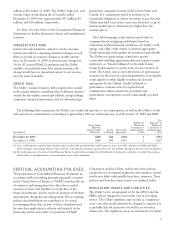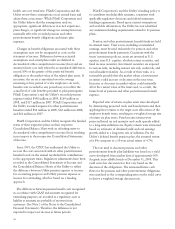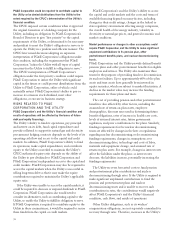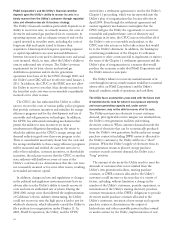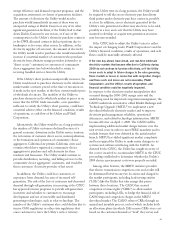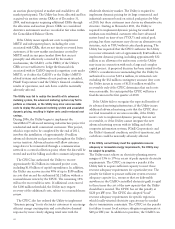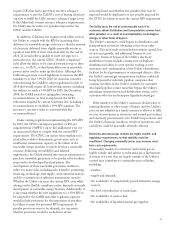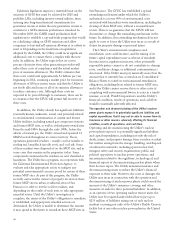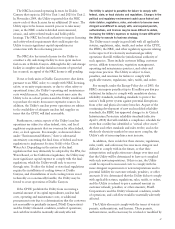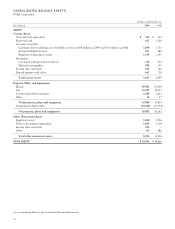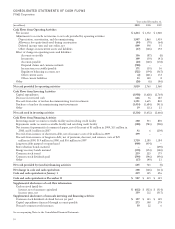PG&E 2009 Annual Report Download - page 46
Download and view the complete annual report
Please find page 46 of the 2009 PG&E annual report below. You can navigate through the pages in the report by either clicking on the pages listed below, or by using the keyword search tool below to find specific information within the annual report.an auction phase (priced at market and available to all
market participants). The Utility has been allocated and has
acquired via auction certain CRRs as of December 31,
2009, and anticipates acquiring additional CRRs through
the allocation and auction phases. CRRs are considered
derivative instruments and are recorded at fair value within
the Consolidated Balance Sheets.
If the Utility incurs significant costs to implement
MRTU and subsequent phases, including the costs
associated with CRRs, that are not timely recovered from
customers; if the new market mechanisms created by
MRTU result in any price/market flaws that are not
promptly and effectively corrected by the market
mechanisms, the CAISO, or the FERC; if the Utility’s
CRRs are not sufficient to hedge the financial risk
associated with its CAISO-imposed congestion costs under
MRTU; or if either the CAISO’s or the Utility’s MRTU-
related systems and software do not perform as intended,
PG&E Corporation’s and the Utility’s financial condition,
results of operations, and cash flows could be materially
adversely affected.
The Utility may fail to realize the benefits of its advanced
metering system, the advanced metering system may fail to
perform as intended, or the Utility may incur unrecoverable
costs to deploy the advanced metering system and associated
dynamic pricing, resulting in higher costs and/or reduced cost
savings.
During 2006, the Utility began to implement the
SmartMeterTM advanced metering infrastructure project for
residential and small commercial customers. This project,
which is expected to be completed by the end of 2011,
involves the installation of approximately 10 million
advanced electricity and gas meters throughout the Utility’s
service territory. Advanced meters will allow customer
usage data to be transmitted through a communication
network to a central collection point, where the data will be
stored and used for billing and other commercial purposes.
The CPUC has authorized the Utility to recover
approximately $2.2 billion in estimated project costs,
including $1.8 billion of capital expenditures. In addition,
the Utility can recover in rates 90% of up to $100 million
in costs that exceed the authorized $2.2 billion without a
reasonableness review by the CPUC. The remaining 10%
will not be recoverable in rates. If additional costs exceed
the $100 million threshold, the Utility may request
recovery of the additional costs, subject to a reasonableness
review.
The CPUC also has ordered the Utility to implement
“dynamic pricing” for its electricity customers to encourage
efficient energy consumption and cost-effective demand
response by more closely aligning retail rates with the
wholesale electricity market. The Utility is required to
implement dynamic pricing for its large commercial and
industrial customers based on critical peak prices by May
of 2010, but these customers may choose an alternative rate
structure. Starting in November 2011, the Utility is
required to implement dynamic pricing for small and
medium non-residential customers who have advanced
meters based on time-of-use (“TOU”) and critical peak
pricing, but these customers may choose an alternative rate
structure, such as TOU without critical peak pricing. The
Utility has requested that the CPUC authorize the Utility
to recover estimated costs of approximately $160 million to
implement dynamic pricing, including approximately $32
million as an allowance for unforeseen costs the Utility
may incur in connection with such a large and complex
capital project. A proposed decision has been issued for the
CPUC’s consideration recommending that the Utility be
authorized to recover $123.6 million, its estimated costs
excluding the $32 million contingency amount. Any costs
the Utility incurs in excess of $123.6 million would be
recoverable only if the CPUC determines that such costs
were reasonable. It is anticipated the CPUC will issue a
final decision in the first quarter of 2010.
If the Utility fails to recognize the expected benefits of
its advanced metering infrastructure, if the Utility incurs
additional advanced metering costs that the CPUC does
not find reasonable or are unrecoverable, if the Utility
incurs costs to implement dynamic pricing that are not
recoverable, or if the Utility cannot integrate the new
advanced metering system with its billing and other
computer information systems, PG&E Corporation’s and
the Utility’s financial condition, results of operations, and
cash flows could be materially adversely affected.
If the Utility cannot timely meet the applicable resource
adequacy or renewable energy requirements, the Utility may
be subject to penalties.
The Utility must achieve an electricity planning reserve
margin of 15% to 17% in excess of peak capacity electricity
requirements. The CPUC can impose a penalty if the
Utility fails to acquire sufficient capacity to meet these
resource adequacy requirements for a particular year. The
penalty for failure to procure sufficient system resource
adequacy capacity (i.e., resources that are deliverable
anywhere in the CAISO-controlled electricity grid) is equal
to three times the cost of the new capacity that the Utility
should have secured. The CPUC has set this penalty at
$120 per kW-year. The CPUC also adopted “local”
resource adequacy requirements for specific regions in
which locally-situated electricity capacity may be needed
due to transmission constraints. The CPUC set the penalty
for failure to meet local resource adequacy requirements at
$40 per kW-year. In addition to penalties, the CAISO can
42



